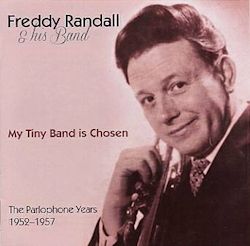
|
FREDDY RANDALL AND HIS BAND My Tiny Band Is Chosen: The Parlophone Years 1952-1957
|
1. I Ain’t Gonna Give Nobody None of My Jelly Roll
2. Dark Night Blues
3. Clarinet Marmalade
4. Original Dixieland One-Step
5. If I Could Be with You
6. Tishomingo Blues
7. Walking the Dog
8. Smokey Mokes
9. The Sheik of Araby
10. At the Jazz Band Ball
11. Sunday
12. My Tiny Band Is Chosen
13. Hindustan
14. Memphis Blues
15. November Blues
16. Ja Da
17. Sugar
18. That Da Da Strain
19. Ain’t Misbehavin’
20. Esax
21. Jealousy
22. Avalon*
23. Mood Indigo*
24. New Orleans Masquerade*
*Bonus Tracks (from acetates, not Parlophone)
Collective Personnel:
Freddy Randall – Trumpet (vocal tracks 1 and 5)
Norman Cave, Dave Keir, Pete Hodge, Orme Stuart – Trombone
Bruce Turner, Al Gay – Clarinet, soprano saxophone, alto saxophone,
Betty Smith – Tenor saxophone
Lennie Felix, Art Straddon, Dave Fraser, Harry Smith, Syd Boatman, Eddie Thompson – Piano
Lew Green, Bob Coram – Guitar, Banjo
Ted Palmer, Ron Stone, Harry Smith, Jack Peberdy, Gerry Salisbury – Bass
Lennie Hastings, Stan Bourke, Buzz Green – Drums
Billy Banks – Vocal (tracks 6 and 7)
Recorded between Jan. 30, 1952 and May 13, 1957
Back in the late forties/early fifties just as the traditional jazz revival was getting underway in the U.K., two schools were emerging in the trad. camp: those of the New Orleans style and the Chicago style. At the time Freddy Randall was in his late twenties. Born in 1921, he was slightly older than his peers Barber (b. 1930) and Colyer (b. 1929), but unlike them he enlisted under the Chicago banner rather than the New Orleans one.
Even though he was a self-taught musician, Randall acquired superb technique on his horn. He was, as Steve Voce put it, a “flashy player,” who liked center stage and the spotlight; so the Chicago style, with its emphasis on solos rather than the ensemble orientation of the New Orleans one, was more appealing to him. Among his early inspirations were Muggsy Spanier and Wild Bill Davidson. Like them he opted for the guitar over the banjo in the rhythm section most of the time, and unlike the traditional jazz purists, he was not averse to having the saxophone, often the tenor, in the front line. In these cases he usually dispensed with the guitar in the rhythm section, keeping the band’s personnel number to seven (most likely for economic reasons). In addition, Randall did not read music, a deficiency which did not prove to be an impediment with the freewheeling style of band he developed, nor did it stand in his way to composing tunes, several of which are on this disc.
One of these, Dark Night Blues, opens with a single string guitar lead of triplets, followed by the same triplet pattern picked by the ensemble and repeated, before rounding off the strain leading up to Randall’s plunger mute solo, a tour de force that is nothing short of brilliant, including, as it does, some double-time phrasing. It, in turn, is followed by stop time two-bar phrases traded by clarinet and trombone, the ensemble then taking over, repeating the triplet pattern of the opening measures, with Randall again dominating as they move into the coda. While not exactly a tune that one will come away from humming or whistling, this rendition of it is superb and ensures it is near, if not at the top, of Randall’s performances.
Randall’s other compositions on this disc—My Tiny Band Is Chosen, November Blues, and Esox—are not as striking, the first being a Mardi Gras-type march, the second a decent blues, and the third containing an interesting alternation of 12-bar choruses between single and double time, the former by solo instruments in turn, the latter by ensemble responses. None is trite or cliché-ridden. Esox appears to be the only track on the disc from a live recording.
All of the other tracks on this CD exemplify Randall’s tastes and provide opportunities for him to apply his technique. He is ably supported by whomever who had in his band, the most notable, perhaps, being Bruce Turner on reeds, also self-taught (and later long-time sideman with Humphrey Lyttelton), who is present on about half of the tracks. Although it was not a reading band hence had no written arrangements, there had to be head arrangements and road maps so all would know when and where to come in, as Dark Night Blues for one illustrates. Perhaps in part because of this, the band romps through the faster tempo tunes, but is also adept at turning out a good blues. Given the duration of each track, clearly most are aimed at the limit imposed by 78 r.p.m. records, with the exception, perhaps, of the last three “bonus” tracks, all never before issued.
Those who remember this band from that time will have pleasant reminiscing spurred by the CD. I certainly did, remembering when, on a tour in the early fifties, Randall had a week’s residency at the Empress Ballroom in Dundee and I was lucky enough to see and hear him there. For those who were not as fortunate and/or possibly are unfamiliar with Randall and his groups, this CD will provide a nice glimpse of what they missed.
It is available on Amazon and elsewhere on line and also from Lake Records at http://www.fellside.com.
Bert Thompson